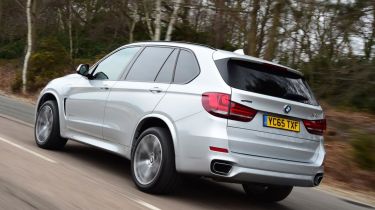Used BMW X5 (Mk3, 2013-2018) review - How much will it cost?
Strong residuals have kept prices up, but running costs are aided by the good fuel economy
Being a premium car, the BMW X5 Mk3 won’t be as affordable as more mainstream alternatives, and good residuals means dirt cheap bargains are few and far between. Running costs should be a lot easier to stomach, though, with the frugal diesels making the most sense if you regularly do lots of motorway journeys.
Prices
By large upmarket SUV standards, the BMW X5 Mk3 had good residual values, which means it may be a struggle to find one at a bargain price. However, thanks to the effects of depreciation, it should be possible to pick one up for a noticeably lower price than what the car was worth brand new.
The diesel models will be the most affordable options of all on the used market, and their plentiful supply means you will have a good few options when shopping around. In comparison, the plug-in hybrid and petrol options are much rarer, due to the fact they sold in far fewer numbers than the diesel models. Expect to pay a premium across the board for versions that were loaded with optional extras when new.
You can check out the latest used prices for the BMW X5 Mk3 by checking out the live used listings on our Find a Car service. To view the true value of our car you can also use our free car valuation tool.
Fuel economy and CO2 emissions
On paper, the 40e plug-in hybrid version of the BMW X5 Mk3 promises the lowest running costs. The claimed fuel economy of 85.6mpg makes it officially the most efficient version of the SUV, and the CO2 emissions of 77g/km means it’s very affordable to tax. However, as the fuel economy is reliant on you using as much of the car’s electric-only driving range of up to 19 miles as possible, you’ll only come close to that if you regularly do lots of short journeys and can keep the battery pack topped up as frequently as possible.
Used - available now
If you do lots of longer journeys, the diesel models will be the better fit for your needs. The most frugal option is the entry-level 25d engine – in rear-wheel drive spec, it can return 50.4mpg and emit 149g/km of CO2; for all-wheel-drive versions, this changes to 48.7mpg and 154g/km. Both the 30d and 40d can return up to 45.6mpg, although the former emits marginally less CO2 (162g/km) than the latter (166g/km). The range-topping M50d is the least efficient diesel, even if the claimed 42.2mpg and 177g/km are pretty decent considering the performance this version has.
Perhaps unsurprisingly, the petrol models with their big and powerful V8 engines are the least frugal of all the BMW X5 Mk3 variants. The 50i returns 27.2mpg and emits a hefty 242g/km of CO2, and the X5 M will be even more expensive to run thanks to its 25.4mpg and 258g/km emissions.
Running costs
Like many other BMWs, the X5 Mk3 has a condition-based rather than a fixed service schedule, which means the car monitors the condition of key components on the car and alerts the driver with a dashboard prompt when maintenance work is needed. The longest gap a BMW X5 Mk3 will go between needing check-ups is 24 months or 18,000 miles, whichever comes soonest.
Servicing costs do vary, depending on the model. For instance, a check-up for the entry-level 25d diesel will range from between £140 to £497, £159 to £519 for the mid-range 30d diesel and £167 to £544 for the 40e plug-in hybrid. There are some consistencies across the models though: as all of the X5 Mk3’s engines are chain driven, there aren’t any cambelts that need replacing after a set amount of time.











